Methods of treating melanoma
a technology of melanoma and treatment methods, applied in the field of treatment methods of melanoma, can solve the problems of increased cellular proliferation and oncogenic activity, poor prognosis of advanced melanoma, and limited treatment options for metastatic melanoma
- Summary
- Abstract
- Description
- Claims
- Application Information
AI Technical Summary
Benefits of technology
Problems solved by technology
Method used
Image
Examples
example 1
A Phase 3 Study of Nab-Paclitaxel Versus Dacarbazine in Chemotherapy-Naïve Patients with Metastatic Malignant Melanoma
[0285]Chemotherapy-naïve patients with stage IV cutaneous metastatic malignant melanoma were enrolled. The patients had Eastern Cooperative Oncology Group (ECOG) PS 0-1, measurable disease, and lactate dehydrogenase (LDH) levels≦2.0× Upper Limit of Normal (ULN), and had no current brain metastases. The patient baseline characteristics are shown in Table 5. The patients were divided into two arms: (1) Nab-paclitaxel (“Nab-P,” Abraxane®) 150 mg / m2, intravenous, no premedication, on days 1, 8, and 15 of 28-day cycle; (2) dacarbazine (DTIC) 1000 mg / m2, intravenous, on day 1 of 21-day cycle. FIG. 1 shows the phase 3 study design.
TABLE 5Baseline CharacteristicsNab-AllpaclitaxelDacarbazinePatientsVariable(n = 264)(n = 265)(N = 529)AgeMedian years62 (21, 85)64 (28, 87)63 (21, 87)(min, max)SexMale, %666666RegionNorth America,444444%Western Europe,434343%Australia, %131313ECOG...
example 2
A Phase 3 Study of Nab Paclitaxel Versus Dacarbazine in Previously Untreated Patients with Metastatic Malignant Melanoma
[0292]The main purpose of this study is to compare the safety, tolerability, and anti-tumor activity of an investigational drug, Nab-paclitaxel (Abraxane®) versus dacarbazine in patients with metastatic melanoma who have not previously received chemotherapy.
[0293]Treatment arm A: Patients who receive Nab-paclitaxel would be dosed intravenously over approximately 30 minutes without steroid pre-medication and without G-CSF prophylaxis (unless modified as described below); 150 mg / m2, on days 1, 8, and 15 every 4 weeks. Treatment arm B: Patients who receive dacarbazine would be dosed intravenously at 1000 mg / m2 on Day 1 with steroid and antiemetic pre-medication; treatment repeated every 21 days.
[0294]The primary efficacy endpoint is progression-free survival (PFS) based on a blinded radiology assessment of response using RECIST response guidelines. The secondary outco...
example 3
Phase I Study of Hepatic Arterial Infusion of Nab-Paclitaxel (Abraxane®) in Patients with Metastatic Melanoma in the Liver
[0298]This is an open-label, Phase I dose-escalation study to determine the response rate of metastatic melanoma to the liver when treated with Abraxane® administered via hepatic artery one day every three weeks. Secondary objectives are to determine the duration of response in the liver, survival (overall survival or progression-free survival), and safety.
[0299]Patients meeting all inclusion / exclusion criteria are enrolled in groups of 3 to 6 to receive Abraxane® infusion once every 21 days. The maximum tolerable dose is determined after two cycles of study treatment. Dose limiting toxicity is defined as: ≧grade 3 non-hematologic toxicity (or the receipt of optimal symptomatic treatment for ≧grade 3 nausea, vomiting, or diarrhea), any grade 4 transaminitis, grade 3 neutropenia with fever requiring hospitalization for parenteral antibiotics, grade 4 neutropenia l...
PUM
| Property | Measurement | Unit |
|---|---|---|
| diameter | aaaaa | aaaaa |
| median survival time | aaaaa | aaaaa |
| particle size | aaaaa | aaaaa |
Abstract
Description
Claims
Application Information
 Login to View More
Login to View More - R&D
- Intellectual Property
- Life Sciences
- Materials
- Tech Scout
- Unparalleled Data Quality
- Higher Quality Content
- 60% Fewer Hallucinations
Browse by: Latest US Patents, China's latest patents, Technical Efficacy Thesaurus, Application Domain, Technology Topic, Popular Technical Reports.
© 2025 PatSnap. All rights reserved.Legal|Privacy policy|Modern Slavery Act Transparency Statement|Sitemap|About US| Contact US: help@patsnap.com



